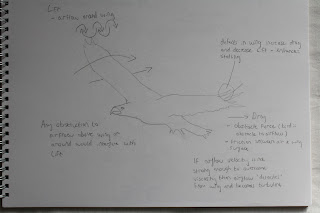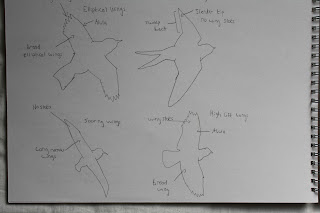Action Analysis

Tuesday, 30 April 2013
Sunday, 28 April 2013
Character Interaction
Here are some of my own videos showing someone lifting light and heavy objects:
The light basket was an easy load on the body and required little effort to carry. The back was straight and body in a comfortable upright position.
The heavy chair required more effort to lift which resulted in a slightly arched back and the knees bent a bit to support the weight.
The heavy box required two people. They had to synchronize together to balance the weight between them. This resulted in both bending the knees and lifting at the same time and putting it down at the same time. They also had bent knees and straight arms to support the weight.
Saturday, 27 April 2013
Quadruped Locomotion
I began investigating the dynamics of quadrupeds by first looking at their skeletal anatomy. This showed me the location of the pivot points in the animal, the angle of the shoulders and the joints and bends, which showed me the limits of the animals legs. I also noticed they have digitigrade feet (walk on their toes). This generally makes them move more quickly and quietly than other mammals.
I filmed some video footage of my friends dog running up and down the beach. This allowed me to get some indication of their leg movement.
I noticed the dogs body moves side to side just as a humans body does, the chest and hips move not just the legs. I observed the standard sequence for a dog when walking is: Right front leg, left front leg, right back leg, left back leg.
Dogs are cursorial quadrupeds, their legs stand them in the upright position, with the femur and humerus held towards the vertical. The cursorial structure helps make the animal more suited to running at high speeds.
I did some further research into quadruped locomotion and came across Eadweard Muybridge. He was an English photographer important for his pioneering work in photographic studies of motion. Producing over 100,000 images of animals and humans in motion, he captured what the human eye could not distinguish as separate movements.
Here are some examples of his work:
This really helped me identify each seperate movement and the passing and stride positions. The length of the stride widens with the speed of the walk.
This video is a series of Eadweard muybridge's photographs animated to show a horse galloping.
Another bit of video reference i found online of a dog running in slow motion:
I noticed the dogs body moves side to side just as a humans body does, the chest and hips move not just the legs. I observed the standard sequence for a dog when walking is: Right front leg, left front leg, right back leg, left back leg.
Dogs are cursorial quadrupeds, their legs stand them in the upright position, with the femur and humerus held towards the vertical. The cursorial structure helps make the animal more suited to running at high speeds.
I did some further research into quadruped locomotion and came across Eadweard Muybridge. He was an English photographer important for his pioneering work in photographic studies of motion. Producing over 100,000 images of animals and humans in motion, he captured what the human eye could not distinguish as separate movements.
Here are some examples of his work:
This really helped me identify each seperate movement and the passing and stride positions. The length of the stride widens with the speed of the walk.
This video is a series of Eadweard muybridge's photographs animated to show a horse galloping.
Another bit of video reference i found online of a dog running in slow motion:
Wednesday, 24 April 2013
Bird Flight Dynamics
I have gathered together a varied collection of my own primary research, investigating birds and their flight dynamics. This has given me a better understanding of the subject matter, which will allow me to animate this more realistically and effectively.
I began my research by taking my own photographs and filming birds in flight.
These are a series of photographs showing an owl and falcon in flight. I captured these at Noah's Ark farm zoo in Bristol.
These photo's show an owl flying towards the camera and landing on a post:
Here you can observe the owl shedding momentum, timed to arrive at a precise point:
Gravitational force used to shed momentum
More examples of the owl flying towards the camera and shedding momentum to land:
The negative angle of attack in owl wings produces downward lift that allows the owl to gather momentum.
The positive angle of attack in owl wings produces upward lift that brings the owl up in position to land.
Shedding momentum.
This series of photographs shows a falcon flying and landing.
These photo's captured key points in a birds flight, however they did not capture the full motion and flying cycle. It was difficult to take photo's fast enough to capture the full movement. So i set about trying to get some filmed footage.
These are some short clips i captured at Attenborough Nature Reserve in Nottingham. The quality is quite poor and i didn't manage to film any great examples of a flying cyle, but you get a general idea.
Some extra footage of ducks walking:
These are some good quality, slow-motion videos from the internet that further helped me research and investigate bird flight dynamics.
Viewing the birds fly in slow-motion really helped me see in detail each movement and action in it's flight.
It made me more aware of how wing shape and structure play an important role in the method of flight.
For example elliptical wings are shorter in length which allows for quick acceleration and rapid turning.
Another example of wing types playing a different role in flight are high aspect-ratio wings, found on many soaring sea birds. The wings are long and narrow with no slotting. This allows for high speed flight and slow speed flight as well as dynamic soaring. Dynamic soaring uses different wind speeds at different heights above the waves in the ocean to provide lift.
Once in the air different birds have different methods of staying there:
- Dynamic soaring - based on the existance of velocity gradients from the surface of the water. High aspect ratio winged birds fly down to the surface of the water with the wind to build up speed. They then bank at the water surface and use the speed to climb against the wind (The lift force is produced by the action of air flow on the wing, which is an airfloil. The lift force occurs because the air has a lower pressure just above the wing and higher pressure below.) They continue climbing until drag causes loss of momentum, and glide back down again repeating the cycle. This allows the bird to remain in the air without flapping, which greatly decreases their flight cost.
- Flapping flight - used by birds that only fly for short distances. During flapping flight, the secondary flight feathers provide most of the lift, while the primary feathers produce thrust and propel the bird through the air. This is the most energy costly method of flight, so birds that stay in the air longer have ways to reduce the costs.
- Static soaring - the upwards movement of the air is equal to the sinking speed of the bird. This occurs in thermals where convection currents are created due to the unequal heating of the ground. It also occurs in obstruction currents, where the wind hits a land obstruction and is deflected upwards.
As well as my own research I used these websites as sources of information to go into more depth on bird flight dynamics:
I did some
additional research into the inventor Étienne-Jules Marey whose methods of
recording movement revolutionized our way of visualizing time and motion.
In the 1860’s
Marey began to study flight, beginning with insects and then birds. He wanted
to understand how the wings interacted with the air that allowed them to fly.
Marey
succeeded in photographing the different phases of the flight of a variety of
birds. In 1890 Marey published a substantial volume entitled Le Vol des Oiseaux
"The Flight of Birds". Alongside the photographs and films, he produced
sets of amazing drawings. In 1887 he created a number of bronze and plaster
sculptures that showed a bird’s full cycle of flight.
These
photographs, drawings and models really helped me visualise each stage in a birds flight
cycle and allowed me to examine them in precise detail.
Here are some examples:
Subscribe to:
Comments (Atom)







































